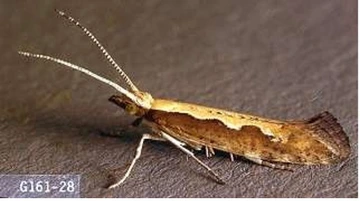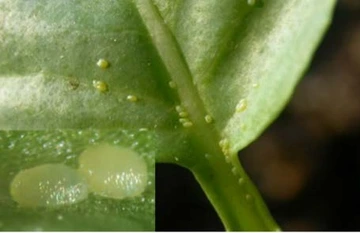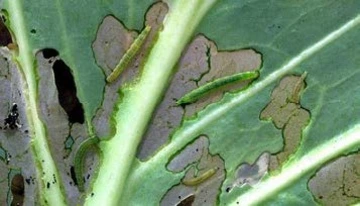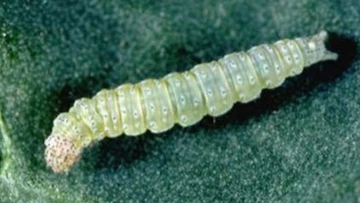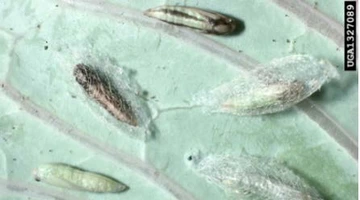The diamondback moth (DBM) is now a major brassica pest in Arizona following an unexpected outbreak a decade ago. Recently, growers and pest control advisors (PCAs) across the state have reported difficulties controlling this pest during the fall 2024 and spring 2025 growing seasons. Diamondback moth populations from several brassica growing regions of California have been reported to be resistant to several groups of insecticides, including chlorantraniliprole (Coragen®, Besiege®), cyantraniliprole (Verimark®, Exirel®), emamectin benzoate (Proclaim®), spinetoram (Radiant® SC), and Bt aizawai (XenTari®, Agree® WG). In Arizona, diamondback moths do not oversummer due to the absence of brassica crops and brassica weeds, combined with extreme heat and dry conditions. As a result, it is believed that new diamondback moth populations arrive each fall in Arizona either by migrating on monsoon or tropical storm winds from brassica-growing regions in Sonora and Baja California, Mexico, or through the introduction of infested transplants from California. Thus, the potential for resistant diamonback moth populations to migrate into Arizona’s brassica growing regions is significant. To mitigate this challenge, growers and PCAs must be proactive by implementing effective integrated pest management and insecticide resistance management strategies.
Biology
Adults
DBM adults are slender, grayish-brown moths, measuring approximately 6 to 12 mm in length. They are marked with a broad, cream or light-brown band along the back that is sometimes constricted to form one or more light-colored diamonds, especially in males.
Eggs
DBM eggs are oval and flattened and measure 0.44 mm in length by 0.26 mm in width. They are generally yellow or pale green. Eggs are laid singly or in clusters of 2 to 8, typically in depressions on the surface of foliage, with most of the eggs on the upper surface.
Larvae
DBM larvae have four instars. The 1st instar is approximately 1.7 mm in length, colorless to pale white, with a dark head capsule. The remaining instars are green. The 4th instar larvae can measure up to 11.2 mm. Their body contains a few short hairs on the sides and is marked by the presence of small white patches. The body is tapered at both ends and features a pair of posterior prolegs, forming a “V” shape. DBM Larvae generally wriggles vigorously backward when disturbed.
Pupae
In preparation for pupation, larvae construct a loose silk cocoon, usually formed on the lower or outer leaves of the plant. Pupation occurs inside the cocoon, and as they mature, the pupae change from a yellowish to a brownish color.
DBMs can reproduce rapidly, leading to sharp population increases over short periods. Under warm conditions (82 - 86°F), they complete their life cycle (egg to adult) in approximately 12 days. The optimal temperature range for development is 77 - 86°F. However, they can remain active in a broader range of temperatures (45 - 90°F). A single female can lay nearly 350 eggs.
Management in greenhouses
Insecticide rotation
Ensure that you rotate insecticides from different IRAC groups. In the event of a DBM control failure with a mode of action (MoA), it is important to rotate with an alternative MoA. It is best practice to reserve the most effective insecticides for protecting crops in the field. This will reduce the selection pressure and allow for better protection of the harvested portion of the crops. Several bioinsecticides, including BotaniGard®, Lepigen®, and PFR-97™ 20% WDG, can provide measurable control of DBM in a greenhouse setting.
Refrain from using off-label materials
Never use insecticides off-label. Not only is it the law, but it also helps preserve these chemistries that are critical for protecting our crops in the field. When recommendations on the insecticide labels are followed, it helps to mitigate resistance.
DBM populations in the greenhouses are isolated from those in the landscape. Treating them repeatedly with the same MoA will cause the development of resistance to occur within a short period due to high selection pressure and a lack of gene exchange from susceptible populations.
Management in the field
Communication
It is essential to communicate with your transplant suppliers (nurseries) to determine if they have encountered any challenges in controlling DBM during production. Information regarding the insecticides that were used to control diamonback moths during production is extremely beneficial from a resistance management standpoint.
Preventive measures
Always check transplants prior to planting. Colonization of fields could begin with the immigration of moths from other areas, or from the movement of infested transplants. PCAs and growers should inspect trays upon arrival at the field by examining several plants from multiple trays to determine if DBM eggs, larvae, or feeding injury are present. Drenching transplant trays with an insecticide solution can help prevent the introduction of DBM into the field. When treating transplants with an insecticide tray drench, such as Verimark (cyantraniliprole), in the nursery immediately before planting, ensure the correct dose is applied for effective control. Cyantraniliprole insecticides provide systemic control of DBM and can provide control for an extended period following transplanting.
Scouting
Proper and timely scouting helps determine the levels of DBM infestations, allowing for timely management decision-making. Early detection of DBM in the field is critical for effective management. Scout frequently once direct-seeded crops emerge, or when plants begin to grow following transplanting. Plants should be inspected for eggs, larvae, and fresh feeding injury (see figure 3).
Sanitation
Field sanitation plays an important role in preventing the buildup of DBM populations. Since crops are often left untreated at harvest, DBM can continue to develop, particularly under warm conditions that accelerate its life cycle. Thus, it is crucial to shred or disk and incorporate crop residues promptly after harvest to break the DBM development cycle. This reduces the risk of moths infesting nearby fields.
Maximize the efficacy of insecticide treatments
It is crucial to follow the recommended rates and label instructions for all insecticides to maximize their efficacy. Low-dose application may result in poor control and lead to the development of resistance. When the crop has a close and dense canopy, it can be difficult for the insecticide treatments to reach DBM larvae that are hidden within layers of leaves. A higher spray volume (with no runoff) is likely to result in more desirable control in this situation. The use of an adjuvant can assist with proper deposition and penetration.
Rotation of modes of action
Insecticide rotation is the cornerstone of insecticide resistance management. It is imperative to rotate MoAs so that alternative materials from a different group are applied in subsequent sprays. It is important to rotate with a different MoA for each DBM generation (i.e., every 4 weeks in mild to 2.5 weeks in hot seasons). This will reduce repeated exposures to the same MoA, thereby reducing the selection pressure. This allows for maintaining susceptibility within the DBM populations.
Enhance biological control
When present, natural enemies can significantly impact DBM populations. The parasitoid wasp species, Diadegma insulare, can provide significant suppression of DBM and appears to be very prevalent in our region. The adoption of recommended action thresholds, the use of selective insecticides, and bordering fields with flowering plants will help to conserve the natural enemies. Natural enemies play a key role in keeping DBM populations in check and can also help slow the development of insecticide resistance by providing nonchemical control.
Regulatory requirements
All transplant shipments from California must be inspected by the California Department of Food and Agriculture (CDFA) or the local County Agricultural Commissioner, and a phytosanitary certificate must be provided. Growers in Arizona receiving shipments of transplants should request and review the phytosanitary certificate to ensure compliance with regulations before planting.
References
Calvin, W. and J. C. Palumbo. 2024. Chlorantraniliprole Resistance Associated with Diamondback Moth (Lepidoptera: Plutellidae) Outbreaks in Arizona Brassica Crops. Journal of Economic Entomology. toae212, https://doi.org/10.1093/jee/toae212
Palumbo, J. C. 2024. 2024-25 Guidelines for Diamondback Moth Management in Desert Cole Crops. http://hdl.handle.net/10150/676905
Grettenberger, I. and J. C. Palumbo. No date. Management Guidelines for Diamondback Moth Management in California.
Philips, C. R., Fu Z., Kuhar T. P., Shelton A. M., and Cordero R. J. 2014. Natural History, Ecology, and Management of Diamondback Moth (Lepidoptera: Plutellidae), With Emphasis on the United States. J. Integ. Pest Mngmt. 5: IPM14012, DOI: http://dx.doi.org/10.1603/IPM14012
Riley D. R. and Sparks A. N. Jr. 2015. Insecticide Resistance Management: Diamondback Moth in Cole Crops. University of Georgia Extension Publications. https://extension.uga.edu/publications/detail.html?number=C899&title=insecticide-resistancemanagement-for-diamondback-moth-in-cole-crops


